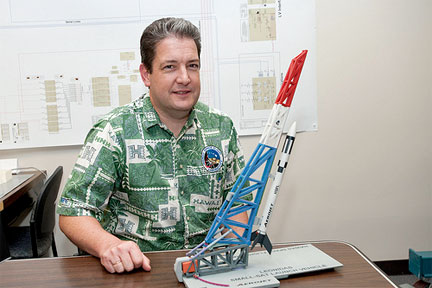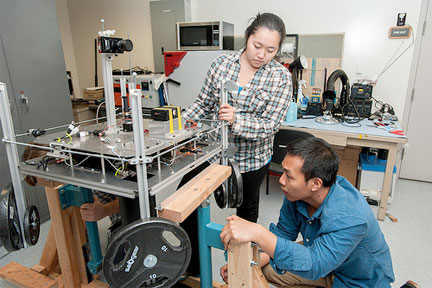
Hawaii Space Flight Laboratory Director Luke Flynn with a model of the launcher and Super Strypi launch vehicle.
...the State of Hawai‘i, which is scheduled for October 2013. When the Super Strypi missile takes flight from the U.S. Navy’s Pacific Missile Range Facility on Kaua‘i, it will be carrying a satellite designed by University of Hawai‘i faculty and students. UH will have also played a significant role in getting that satellite into space.
President M.R.C. Greenwood said, “Hawai‘i is located in a unique position to become a low-cost gateway to space. The University of Hawai‘i is one of the only universities in the world to have both satellite fabrication capabilities and unique, direct access to orbital space.”

Avionics Engineer Amber Imai and Satellite Avionics Assistant Tristan Martinez adjust the satelliteʻs attitude determination and control test bed.
HSFL was established in 2007 within the University of Hawai‘i at Mānoa’s School of Ocean and Earth Science and Technology (SOEST) and the College of Engineering. As a multidisciplinary research and education center, HSFL brings together individuals from diverse area and other UH campuses to work on the exploration and understanding of the space environment. Kaua‘i Community College will be the primary communications link. Honolulu Community College is designing one of the satellite payloads and will operate a receiving station during the mission.
Greenwood said, “The work on this mission is creating invaluable workforce development opportunities and training for students across the University of Hawai‘i system. In addition, UH is helping to develop Hawai‘i’s space science enterprise. We hope our graduates will go to work for related research and technology companies right here in Hawai‘i or will go on to form their own space-science related businesses.”
HSFL Director Luke Flynn says the university would like to be able to launch small satellites on a regular basis, which will attract companies that are looking for affordable ways to test space technology. Flynn says, “The University of Hawai‘i helps to hold down the cost by playing a key role in the research and development of space technology, which also gives students hands-on experiences. This creates a win-win for the university, for the country, for the state, and also for the corporations that are willing to invest.”

